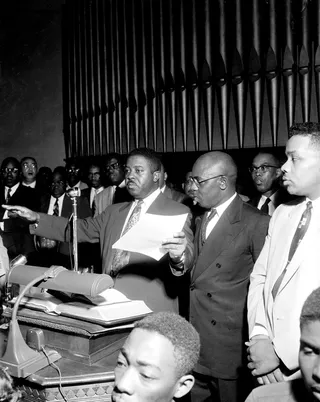History Makers: A Look Back on the Montgomery Bus Boycott 60 Years Later
The arrest of Rosa Parks launched a year-long protest.

1 / 9
The 60th Anniversary of the Montgomery Bus Boycott - Dec. 1, 2015 marks 60 years since Rosa Parks, an African-American woman, boldly took her seat in history by refusing to give up her spot in a whites-only section on a Montgomery, Alabama, city bus. Her arrest led to a more than a year-long organized boycott African-American residents against the racist city bus company. The action led to the Supreme Court decision ruling bus segregation illegal in the state. BET.com looks back at the boycott on this landmark anniversary. (Photo: Underwood Archives/Getty Images)

2 / 9
Before Rosa Parks - The Women’s Political Council, a group of Black professionals formed in 1946, began challenging the practice of making Blacks enter from the back of the bus and not giving them the same bus service in their neighborhoods as in the white part of town. After failed attempts to receive support for changes from Mayor W.A. Gayle in early 1954, African-American groups warned the city that a boycott was brewing. (Photo: Photo12/UIG/Getty Images)

3 / 9
Young Rebels: Claudette Colvin and Mary Louise Smith - Before Rosa Parks became the face of the Montgomery bus boycott, there were other individuals who protested segregation on city buses. In 1955, Claudette Colvin, a 15-year-old girl, was arrested for not giving up her seat. In the following months, Mary Louise Smith, 18, was arrested for the same reason.(Photo: Bettmann/Corbis)

4 / 9
The Woman Who Changed It All - Before she became “the mother of the civil rights movement,” Parks was an active member of the Montgomery NAACP and was the organization’s secretary. On Dec. 1, 1955, Parks decided to follow the actions of the younger demonstrators before her. After Parks’s arrest, the Women’s Political Council began organizing and spreading the word about a one-day boycott. A planning meeting took place at Martin Luther King Jr.’s Dexter Avenue Baptist Church on Dec. 2. (Photo: Bettmann/Corbis)

5 / 9
Formation of Montgomery Improvement Association - The initial boycott brought out hundreds of people. Building on that momentum, the Montgomery Improvement Association was formed on Dec. 5, 1955. The organization was led by Martin Luther King Jr. and local black leaders and ministers. The MIA drafted the following demands: “courteous treatment by bus operators; first-come, first-served seating; and employment of Negro bus drivers,” according to King Encyclopedia. They vowed to continue protesting until their demands were met. (Photo: New York Times Co./Getty Images)
ADVERTISEMENT

6 / 9
Unity for the Cause - The MIA campaign was supported by collecting money at meetings and from civil rights organizations around the country. The NAACP also helped in bringing legal action against the city for its bus segregation laws. Carpools were formed to take individuals to their destinations.(Photo: Bettmann/Corbis)
Photo By Photo: Bettmann/Corbis

7 / 9
Pushback From Montgomery Officials - The bus boycott continued through 1956. Montgomery officials sought to weaken the movement by taking down the leadership, including Martin Luther King Jr. On Jan. 30, 2016, King’s house was bombed. No one in his family was injured in the attack. Still the boycott continued. In February 1956, 89 leaders were indicted for disobeying a state anti-boycott law. King was brought to trial and convicted for his actions.(Photo: Bettmann/Corbis)

8 / 9
Challenging the Law - Attorney, minister and legal advisor to Rosa Parks and the MIA, Fred David Gray filed a petition against the constitutionality of the laws that allowed segregation on Alabama buses on Feb. 1, 1956. Browder v. Gayle included plaintiffs Aurelia S. Browder, Susie McDonald, Claudette Colvin, Mary Louise Smith and Jeanatta Reese. Mayor William A. Gayle, Montgomery City Lines, Inc. Other Montgomery officials were defendants. On June 5, 1956, a U.S. District Court panel voted that segregation on Alabama’s buses was unconstitutional. (Photo: Bettmann/Corbis)
